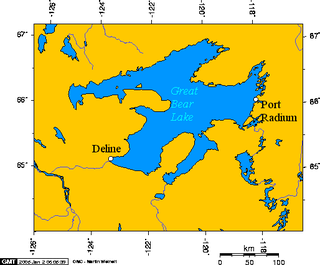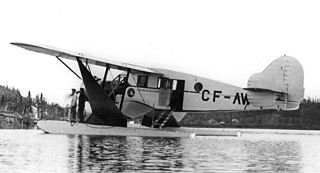
Brownfield refers to land that is abandoned or underutilized due to pollution from industrial use. The specific definition of brownfield land varies and is decided by policy makers and/or land developers within different countries. The main difference in definitions of whether a piece of land is considered a brownfield or not depends on the presence or absence of pollution. Overall, brownfield land is a site previously developed for industrial or commercial purposes and thus requires further development before reuse.

Uranium City is a northern settlement in Saskatchewan, Canada. Located on the northern shores of Lake Athabasca near the border of the Northwest Territories, it is 230 m (750 ft) above sea level. The settlement is 760 km (470 mi) northwest of Prince Albert, 760 km (470 mi) northeast of Edmonton and 48 km (30 mi) south of the Northwest Territories-Saskatchewan boundary. For census purposes, it is located within the province's Division No. 18 territory.

Port Radium is a mining area on the eastern shore of Great Bear Lake, Northwest Territories, Canada. It included the settlement of Cameron Bay as well as the Eldorado and Echo Bay mines. The name Port Radium did not come into use until 1936 and at the time it was in reference to the region as a whole. The Eldorado mine site at LaBine Point adopted the name for its settlement in the 1940s and it has generally stuck.

The Radium King was built in 1937 to haul ore on the Mackenzie River, and her tributaries. This included uranium used in the US atom bombs of World War II. Later in her active career she hauled barges on Great Slave Lake.
Gilbert A. LaBine, was a Canadian prospector who, in 1930, discovered radium and uranium deposits at Port Radium, Northwest Territories. He has become known as the father of Canada's uranium industry. LaBine was president of Eldorado Gold Mines from its start in the late 1920s to 1947. He left the company, which had become a Crown corporation in 1944, to prospect for uranium minerals as an independent mine developer. In the 1950s he brought the Gunnar Mine to production at Uranium City, Saskatchewan.
The Rayrock Mine was a uranium producing venture in the Northwest Territories, Canada. It is located on the south side of Maryleer Lake and the north shore of Fault Lake, 169 kilometers northwest of Yellowknife and 74 kilometres northwest of Rae. Radioactive deposits were originally staked in 1948 and then restaked in 1950. American Yellowknife Mines Limited explored the site with detailed Geiger surveys and extensive trenching in the early 1950s. In 1954 exploration work included over 10,000 feet (3,000 m) of surface diamond drilling, and the company was reorganized as Rayrock Mines Limited.

The Eldorado Mine is a defunct mine located in Port Radium, Northwest Territories, Canada. The site, which covers 12 hectares, is located next to Echo Bay in the shore of Great Bear Lake.

Cameco Corporation is the world's largest publicly traded uranium company, based in Saskatoon, Saskatchewan, Canada. In 2015, it was the world's second largest uranium producer, accounting for 18% of world production.
Boris Pregel was a Russian Empire-born Jewish engineer and dealer in uranium and radium. He was born in Odessa, in the Russian Empire, and studied engineering in Belgium at the Free University of Brussels and the University of Liège. He served in the Russian army in World War I, entering as a private soldier and rising to the rank of colonel of engineers. He was put in charge of Russia's only aircraft factory. He moved to Paris after the October Revolution.

Madawaska Mine (previously known as Faraday Mine) is a decommissioned underground uranium mine in Faraday, near the town of Bancroft, Ontario, which produced 9 million pounds (4,082 tonnes) of U3O8 concentrate, at an average ore grade of 0.1074%, during its two periods of production.
Canada has an active anti-nuclear movement, which includes major campaigning organisations like Greenpeace and the Sierra Club. Over 300 public interest groups across Canada have endorsed the mandate of the Campaign for Nuclear Phaseout (CNP). Some environmental organisations such as Energy Probe, the Pembina Institute and the Canadian Coalition for Nuclear Responsibility (CCNR) are reported to have developed considerable expertise on nuclear power and energy issues. There is also a long-standing tradition of indigenous opposition to uranium mining.

Marine Transportation Services (MTS) formerly Northern Transportation Company Limited (NTCL) is a marine transportation company operating primarily in the Mackenzie River watershed of the Northwest Territories and northern Alberta, and the Arctic Ocean using a fleet of diesel tug boats and shallow-draft barges. NTCL filed for bankruptcy in 2016 and its assets were acquired by the Government of the Northwest Territories later that year.

For many years, North America was the largest exporter of uranium ore in the world and has been a major world producer since demand for uranium developed. In 2009 Kazakhstan took over top spot, relegating Canada to second. 20% of the world's primary uranium production came from mines in Canada in 2009. 14.5% of the world production came from one mine, McArthur River. Currently the only producing area in Canada is northern Saskatchewan, although other areas have had active mines in the past.
The Beaverlodge Mine sometimes referred to as the Eldorado Mine or the Beaverlodge Operation was a uranium mine in the community of Eldorado, northern Saskatchewan, Canada. Eldorado was a small community 7 kilometres (4.3 mi) east of the community of Uranium City, Saskatchewan in the Beaverlodge Uranium District built by Eldorado Mining and Refining Limited to house the workforce and families of the mine.
Waterways is a locality within the Regional Municipality of Wood Buffalo in northern Alberta, Canada. It is now a neighbourhood within the Fort McMurray urban service area along the west bank of the Clearwater River, south of the river's confluence with the Athabasca River.
The world's largest producer of uranium is Kazakhstan, which in 2019 produced 43% of the world's mining output. Canada was the next largest producer with a 13% share, followed by Australia with 12%. Uranium has been mined in every continent except Antarctica.

The Radium Queen and her sister ship the Radium King were built in Sorel, Quebec in 1937, for the Northern Transportation Company, a subsidiary of Eldorado Gold Mines. The Radium Queen was a cargo/tug ship that served on the Slave River. It made runs between Lake Athabaska and Great Slave Lake which is generally navigable. The Radium Queen towed barges from the railhead at Waterways, Alberta to a portage around the rapids. Cargo was unloaded there and transported by land, and loaded on barges on the lower river that were towed by the Radium King, and later by other tugboats, like the Radium Charles, Radium Express and Radium Yellowknife.

The Eldorado Radium Silver Express was the name of a semi-regular air service between Edmonton, Alberta and Port Radium, Northwest Territories, or between Port Radium and a refinery at Port Hope, Ontario. A single airplane, a Bellanca Aircruiser, a small bush plane, provided this service, from 1935 to 1947.

The Radium Gilbert was a tugboat built for transporting supplies to, and ore from, the radium and uranium mines in Canada's Northwest Territories. Like the other tugs in the Radium Line she was steel-hulled.

A yellowcake boomtown also known as a uranium boomtown, is a town or community that rapidly increases in population and economics due to the discovery of uranium ore-bearing minerals, and the development of uranium mining, milling or enrichment activities. After these activities cease, the town "goes bust" and the population decreases rapidly.










